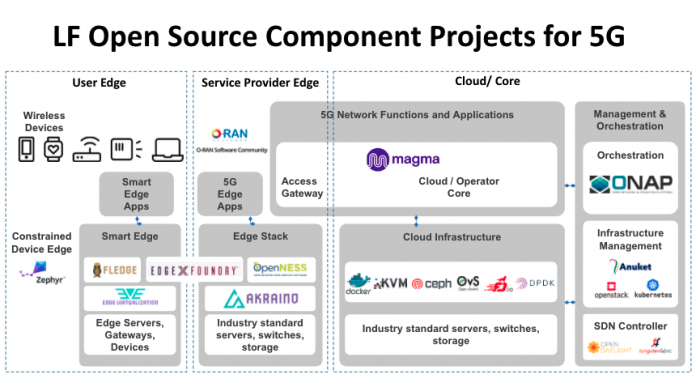There is an exciting convergence in the networking industry around open source, and the energy is palpable. At LF Networking, we have a unique perspective as the largest open source initiative in the networking space with the broadest set of projects that make up the diverse and evolving open source networking stack. LF Networking provides platforms and building blocks across the networking industry that enable rapid interoperability, deployment, and adoption and is the nexus for 5G innovation and integration.
LF Networking has now tapped confluence on industry efforts to structure a new initiative to develop 5G Super Blueprints for the ecosystem. Major integrations between the building blocks are now underway–between ONAP and ORAN, Akraino and Magma, Anuket and Kubernetes, and more.
“Super” means that we’re integrating multiple projects, umbrellas (such as LF Edge, Magma, CNCF, O-RAN Alliance, LF Energy, and more) with an end-to-end framework for the underlying infrastructure and application layers across edge, access, and core. This end-to-end integration enables top industry use cases, such as fixed wireless, mobile broadband, private 5G, multi-access, IoT, voice services, network slicing, and more. In short, 5G Super Blueprints are a vehicle to collaborate and create end-to-end 5G solutions.
Major industry verticals banking on this convergence and roadmap include the global telcos that you’d expect, but 5G knows no boundaries, and we’re seeing deep engagement from cloud service providers, enterprise IT, governments, and even energy.
5G is poised to modernize today’s energy grid with awareness monitoring across Distribution Systems and more.
This will roll out in 3 phases, the first encompassing 5G Core + Multi-access Edge Computing (MEC) using emulators. The second phase introduces commercial RANs to end-to-end 5G, and the third phase will integrate Open Radio Access Network (O-RAN).
The 5G Super Blueprint is an open initiative, and participation is open to anyone. To learn more, please see the 5G Super Blueprint FAQ and watch the video, What is the 5G Super Blueprint? from Next Gen Infra.
Participation in this group has tripled over the last few weeks! If you’re ready to join us, please indicate your interest in participation on the 5G Super Blueprint webpage, and follow the onboarding steps on the 5G Super Blueprint Wiki. Send any questions to superblueprint@lfnetworking.org.
The post Super Blueprints Integrate the 5G Open Source Stack from Core to Door appeared first on Linux Foundation.



